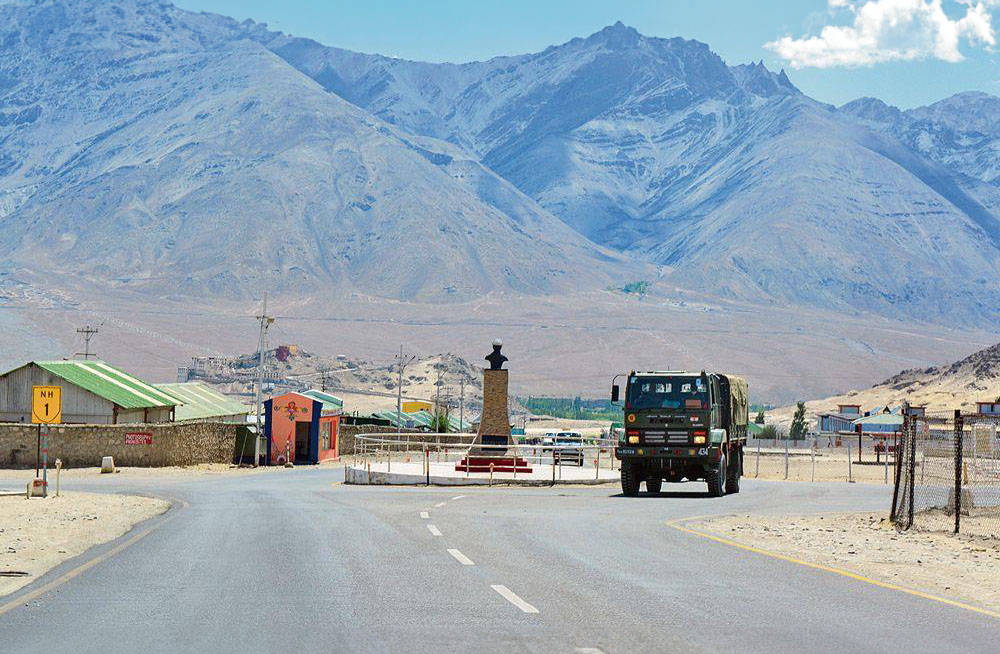(TibetanReview.net, Oct13’24) –As India’s trust-deficit towards China on the border issue continues amid continuing standoff in eastern Ladakh, the country has announced more major strategic infrastructure projects to achieve parity with the developments on the occupied Tibet side of the border. Defence Minister Rajnath Singh on Oct 12 virtually inaugurated 75 infrastructure projects “dedicated to the nation” from Sherathang, near the Indo-Tibet border, most of them in the Tibet-bordering states, reported eastmojo.com Oct 12.
India has also approved plans for the launch of 42 spy satellites and plans to procure over 20,000 new-generation anti-tank guided missiles (ATGMs), along with 1,500 launchers and simulators, for the Indian Army, according to latest media reports.
The 75 projects launched by Mr Singh were stated to include 51 bridges, 22 roads, and two miscellaneous projects, aimed at strengthening connectivity in critical regions.
The road projects were stated to include four for Sikkim, seven for Jammu and Kashmir, three for Arunachal Pradesh, two for Ladakh, besides two for Rajasthan and one each for one for Nagaland and the Andaman and Nicobar Islands.
The 51 bridges were stated to cover key locations, including 14 for Arunachal Pradesh, 12 for Jammu and Kashmir, nine for Ladakh, and others spread across Uttarakhand, Himachal Pradesh, Mizoram, and Sikkim.
Those in Sikkim were stated to include the upgradation of the Sherathang-Kupup road, which plays a crucial role for the armed forces, offering an alternative route from East Sikkim to the Siliguri corridor. In Ladakh, the newly constructed Hemiya Bridge on the Leh-Loma road will improve connectivity to Dungti, the report said.
Singh has inaugurated the projects virtually from Sukna Military Base as inclement weather prevented his planned personal attendance. Sikkim Chief Minister Prem Singh Golay, along with other state dignitaries, has attended the ceremony at Sherathang.
Meanwhile the Cabinet Committee on Security (CCS) led by PM Narendra Modi has quietly approved the phase III of the Space Based Surveillance (SBS-III) for launching an array of spy satellites in low earth and geostationary orbits.
“CCS on Monday gave the approval for launching 52 satellites under the SBS-III project, which would cost around Rs 27,000 crore,” the timesofindia.com Oct 12 quoted a source in the ISRO, India’s space agency, as saying.
“If India is able to launch satellites at this scale, threats to the country can be better mitigated,” the source has said. The recent Cabinet clearance to purchase 31 weaponised Predator drones from US-based General Atomics will add more teeth to the surveillance capability of the SBS-3 mission.
Also, India’s Defence Ministry has issued a Request for Information (RFI) to procure over 20,000 new-generation anti-tank guided missiles (ATGMs), along with 1,500 launchers and simulators, for the Indian Army, reported indiatoday.in Oct 11.
This initiative is aimed at enhancing the Army’s operational capabilities to effectively target and destroy tanks and other armoured vehicles, the report said.
These ATGMs are expected to operate in diverse terrains, including plains, deserts, high altitudes up to 5,500 meters (18,000 feet), as well as coastal areas and islands.
The requirement is that the new-generation missiles must function effectively in both day and night conditions, adapting to various weather scenarios such as rain, fog, humidity, and dust. Additionally, they are required to operate in extreme temperatures ranging from -45°C to 45°C.
And the ATGMs should be able to neutralize a range of targets, including enemy tanks, armoured personnel carriers, low-flying helicopters, concrete structures, and other weapon platforms.
They will be strategically deployed along India’s western border with Pakistan and the northern border with Chinese ruled Tibet, the report said.
The move is a step toward bolstering the Indian Army’s capabilities in modern warfare.

